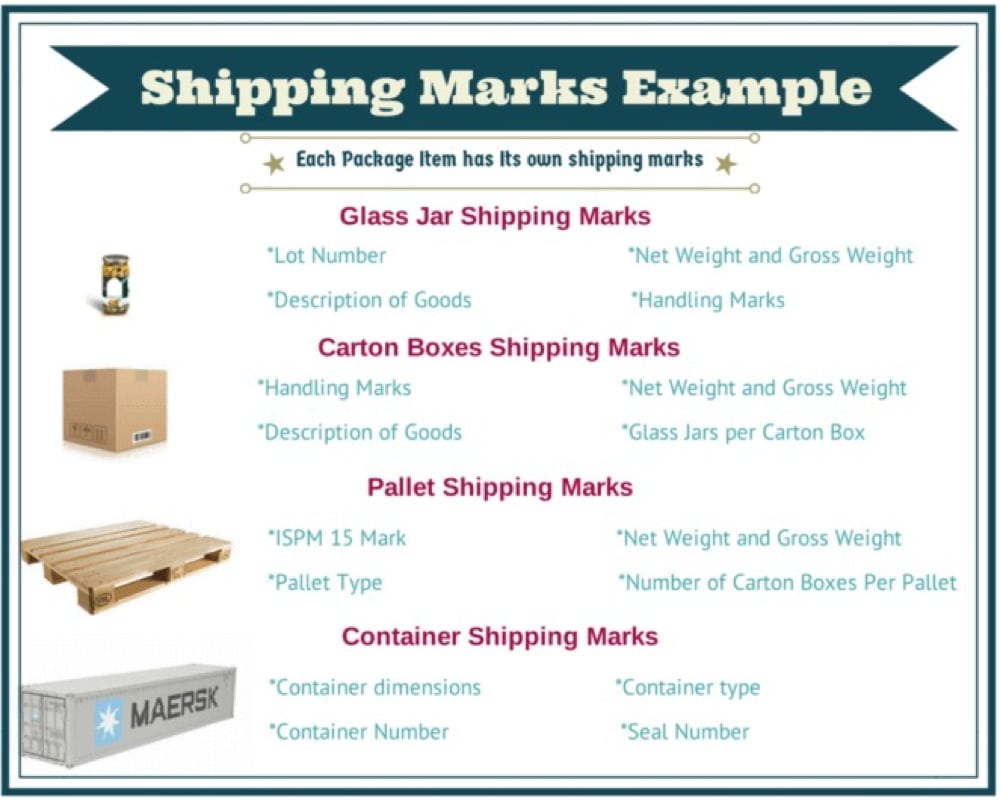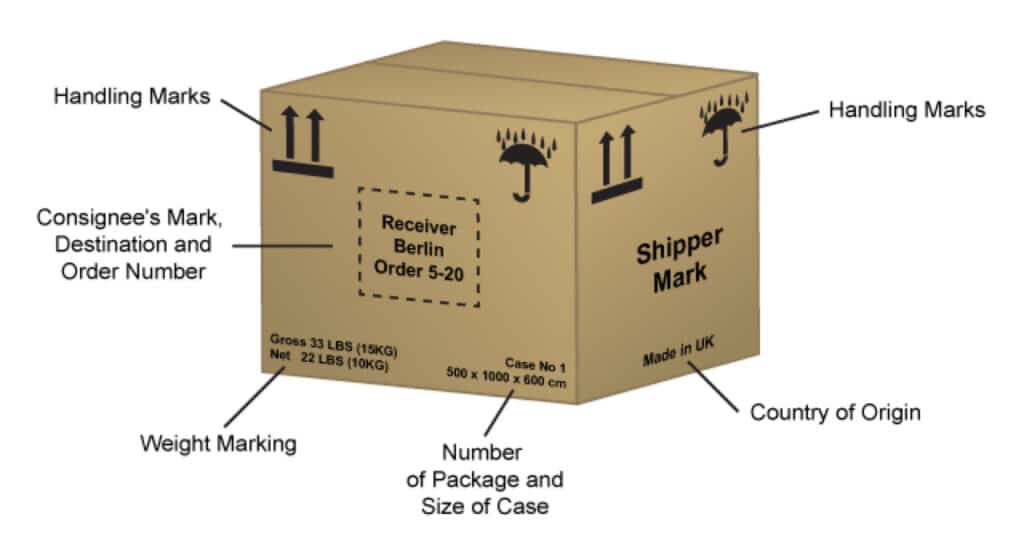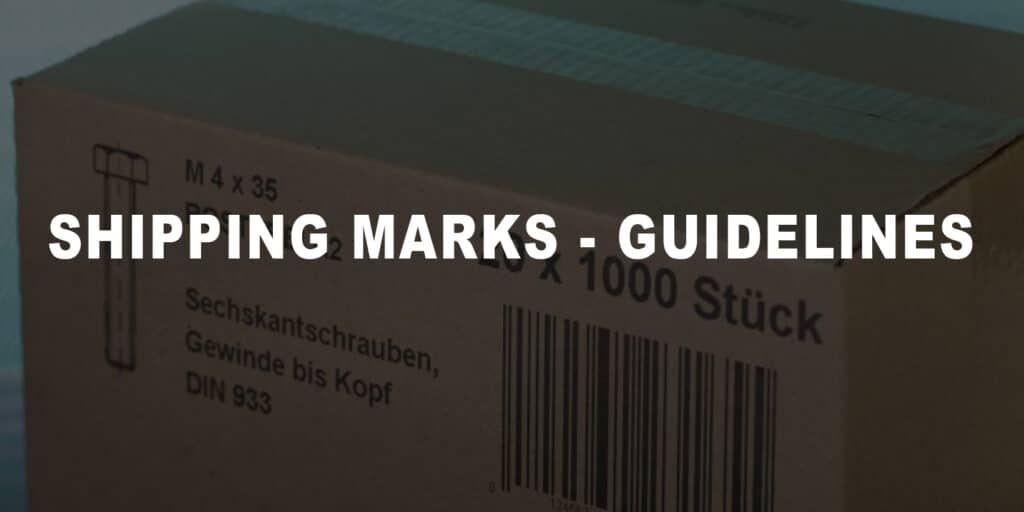
When importing goods from China, it is vital to provide shipping marks to ensure that the handler can identify your goods.
It includes instructions for proper handling and providing the necessary information to ensure proper delivery. Shipping marks can make handling safer and save time, saving you money.
Next, let’s look at what shipping marks are, what types of shipping marks are available, and how to create them properly.
What Is a Shipping Mark?

A shipping mark can be a symbol, word, or number put on the carton of an exported item, which helps the shipment to be handled correctly and efficiently throughout the shipping process.
Shipping marks include the carton size & numbers, country of origin, product number, weight, consignee, and handling marks, which should usually match your supplier’s packing list on these cartons.
Additional information may be listed for managing the items you receive (for example, at the warehouse).
Why Do You Need Shipping Marks?
Shipping marks can quickly identify imported and exported goods.
Whether domestically or internationally, we recommend using shipping marks to indicate that the handler is carrying your goods correctly.
During transportation, inspection, warehousing, customs clearance, and receiving, all shipments are marked with some specification written or used on the outer packaging of the shipment, depending on the requirements of the consignee.
With these shipping marks, the handler can move/load your cargo correctly.
For example, when items arrive at the port, an indicator is needed to tell customs officials, logistics teams, inspection teams, and warehousing personnel how to handle the products.
If the carton has a cold storage mark, they will put it in the freezer. If it is fragile, they will pick/carry the carton carefully.
These shipping marks must be intuitive, as your cartons may be handled by people in different countries who do not know how to read your language.
Remember, it has become a rule to put shipping marks on the cartons that everyone must follow.
No matter which country you are from, you must put the shipping marks, which should be used on each carton for a smooth transaction.
What Are the Main Types of Shipping Marks?

We can classify shipping marks in several ways. First, shipping marks are classified according to their location:
- Package marks
- Carton marks
- Pallet marks
- Container marks
In addition, we can classify the shipping marks into the following categories:
- Cargo Marks
- Document Marks
Shipping marks describe the transported goods, the origin of goods, handling information, type and quantity of inner packaging, net weight, gross weight, details of the consignee, etc.
In addition, for non-conventional cargoes, such as fragile or dangerous goods, there are unique shipping marks, which are handling marks, and these usually show on the shipping marks of the carton.
The following types of shipping marks must appear on your cartons. These shipping marks provide critical information for carrying and handling, identifying the consignee, etc.
1. Handling marks
These are visual shipping marks guiding loading, unloading, or transferring your cartons and how to handle them.
For example, the fragile or dangerous goods we just mentioned require unique shipping marks, significant during handling.
2. Consignee marks
You can put the company name, logo, product name, order number, and other specifics to the consignee mark.
Some e-commerce platforms often require consistent shipping marks (such as Amazon FBA).
3. Country of origin marks
The carton should be marked with the country of origin. For example, this information must be printed on every carton, whether Made in China or Vietnam.
4. Carton number & size marks
You should number the cartons to ensure they arrive at the port together. Mark the total number of cartons and assign a separate number to each carton:
- Carton numbers (1/150, 2/150, 3/150)
- Carton size (LxHxW cm)
5. Weight marks
The weight of the carton must be accurately marked on your important documents.
One of the most common causes of customs delays in the United States is the failure to do so, which is the key to having weight marks printed on cartons.
The following information should be included on each carton:
- Net weight (it is the weight of the item without the container or packaging)
- Gross weight (it is the weight of the entire contents of the carton)
You may learn more on our blog about Gross Weight Vs. Net Weight for details below:
Gross Weight Vs. Net Weight: What is the Difference?
A third-party inspection company should also check the weight of the carton, as this can help you prevent discrepancies between the weight listed on the carton and the actual weight.
What Should be Included in Shipping Marks?

Shipping marks are significant marks that should contain the following:
- Company name or logo
- Carton size
- Carton Numbers
- Weight marks
- Country of origin marks
- Handling marks
What else can be included? Product reference (SKU), order number, and other relevant information about the product.
Such as the size, color, or classification of the different types of goods in the carton, these are usually included in the barcode or RFID tag for faster processing.
Who Provides Shipping Marks?
The buyer provides the primary shipping marks, including the company name, logo, product name, model number, etc.
The seller provides the secondary shipping marks, including the order number, product number, gross weight, net weight, etc.
Generally, the seller designs shipping marks in international trade and does not need to specify them in the contract.
However, if the buyer sets the shipping marks, the buyer and seller must establish the time for the buyer to provide the shipping marks in the packaging contract.
If the buyer does not provide it within the time limit, the seller can decide at its own discretion.
What Are the Guidelines for Using Shipping Marks?

There are some key rules and regulations for shipping marks and handling marks that shipping companies need to follow, which include the following:
Guideline 1. The port marks for designating destination and place of transshipment should be affixed in large, clear letters on three sides of the carton using steel stamps and waterproof ink.
Guideline 2. Shipping marks should include coded marks and avoid using commodities names to ensure that handlers are less likely to know the contents so that items are less likely to be stolen.
Even the code suggests being changed repeatedly to avoid over-familiarity by handlers.
Guideline 3. If any special handling or treatment of the shipment is required, the shipping marks should reflect this information on the bill of lading.
Guideline 4. All shipping warning marks must be clear, permanent, and easy to read.
Guideline 5. The shipping marks need to be in a language that can be understood in both places, such as the language of the package’s origin and destination.
In short, it is highly recommended that steel stamps be used in the production of shipping marks and that non-waterproof materials be avoided whenever possible to read the shipping marks throughout the shipping process.
How to Properly Create Shipping Marks?

Usually, it is up to the importer or buyer to specify the information displayed on the shipping marks.
It should be simple, clear, appropriately sized, easily identifiable, and in strong colors. Shipping marks can be printed or handwritten, but handwritten is more difficult to read.
The important information should be easily accessible. In this case, shipping marks should be placed on each carton’s appropriate side for quick loading and identification.
Before creating shipping marks, you need to keep in mind some considerations, such as:
Primary marks
Consignee’s company name (with/without logo), destination port, country of origin mark, product order number, product number, SKU number, etc.
Side marks
Net and gross weight, carton size, number of cartons ( 1 of 100), bar code, etc.
Handling marks
Handling marks are visual icons that draw the attention of handling personnel and provide instructions when unloading/loading, moving, or storing.
Handling marks indicate the characteristics of your product, such as fragility, perishability, etc.
Clear icons and visualization are important because your shipments will be handled by people in different countries who do not understand your language.
Hazardous materials marks
Suppose you transport any of the nine categories of dangerous goods.
You must ensure that the cartons are labeled with the appropriate hazardous materials marks, as dangerous goods must be handled with care to ensure the safety of the goods and the carrier.
Shipping marks may seem like a minor detail, but if the carton is incorrectly marked, it may create problems for the outcome of the shipment.
Shipping Marks Sample Template
Yansourcing, your export specialist, is committed to making importing from China easier and safer for our customers.
Here is a suggested shipping marks sample template for you.
Supplier Name. [your business name]
Destination. [country where your business is located]
G.W.: [gross weight]
N.W.: [net weight]
Size. [size of your carton]
Order number: [from your supplier]
Number of cartons: 50 [or however many cartons you have]
Country of origin: [Manufacturer’s location, e.g. China]
Shipping Marks FAQ
1. Should I have shipping marks when importing from China?
Yes, we recommend that you use a shipping mark. When your product is shipped internationally, it is important to have clear shipping marks to help the person handling the shipment.
2. How to make shipping marks for cartons?
You can make shipping marks in many ways. Some people use stencils, while others prefer direct printing.
Another method is to print on a sticker and stick it on the carton, which is also a way to add sticker labels. And there is also a straightforward, handwritten version, but this is not recommended.
3. What type of shipping marks are on the carton?
Some important shipping marks need to be on the cartons. The following is a list of important shipping marks.
- Consignee’s name or logo
- Name of the destination port
- Number of cartons
- Product item number
- Net weight and Gross weight
- Carton size
- Handling marks
4. What does the umbrella logo on the carton mean?
You may be familiar with the umbrella logo on the package because it is trendy. It means keeping the carton away from rain or moisture.
5. Shipping marks, labels, and symbols – are they the same?
Shipping marks is a very broad term. Any symbol, word, or number can be considered a shipping mark in export and import transactions.
6. Is there any benefit to making shipping marks on cartons?
Yes, there are many benefits to making shipping marks on cartons.
Firstly, it helps the handler handle the product, resulting in no damage or breakage. Secondly, it prevents any major accidents from happening.
7. Do shipping marks cost money?
It’s free to create a shipping mark, but you aren’t free to ship the goods until you’ve paid for them.
Shipping Marks Conclusion
Shipping marks is a broad term; any symbol, word, or number can be considered a mark. Creating the shipping marks well from the first time, you will find that international shipping is just as easy as domestic shipping.
At last, I hope you enjoy my article and can have your own shipping marks. Either way, please let me know in the quick comments below.
I am Yan, the founder of Yansourcing, the best sourcing agent in China, who can quickly and safely help you buy and import from China. If you need help sourcing from China, please do not hesitate to contact us.
